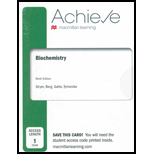
BIOCHEMISTRY-ACHIEVE (1 TERM)
9th Edition
ISBN: 9781319402853
Author: BERG
Publisher: MAC HIGHER
expand_more
expand_more
format_list_bulleted
Question
Chapter 18, Problem 45P
Interpretation Introduction
Interpretation:
Effect on PMF by the reverse action of ATP synthase.
Concept introduction:
The force that promotes the movement of protons across the membrane down the concentration gradient is termed as proton motive force. Mostly, PMF is generated by the electron transport chain. The proton motive force makes the cell to act as the tiny battery. PMF helps the cell perform work or store the energy for future use.
Expert Solution & Answer
Want to see the full answer?
Check out a sample textbook solution
Students have asked these similar questions
Need help ASAP.
Describe the steps by which the F0 portion of the ATP synthase harnesses the proton-motive force to help synthesize ATP. What would you expect to observe if the proton gradient were reversed? Explain your answer.
Reductive power. What ratio of NADPH to NADP+ is required to sustain [GSH] = 10 mM and [GSSG] = 1 mM ? Use the redox potentials given in Table 18.1 .
Fo-F1 ATPase. The energy for ATP synthesis from ADP and Pi is provided by the downhill transport of protons through the rotary FoF1 ATP synthase . The enzyme has 3 alpha-beta and 12 ‘c’ subunits. The mitochondrion maintains change in membrane potential=180 mV (negative inside), pHin = 8, pHout=7, [Pi] = 3 mM and ADP is present as well.
. What [ATP]/[ADP] ratio will be established at steady-state under these conditions?
What would be the [ATP]/[ADP] ratio if the enzyme had only 9 ‘c’ subunits? full revolution of the crank (gamma subunit) produces 3 ATP.
Chapter 18 Solutions
BIOCHEMISTRY-ACHIEVE (1 TERM)
Ch. 18 - Prob. 1PCh. 18 - Prob. 2PCh. 18 - Prob. 3PCh. 18 - Prob. 4PCh. 18 - Prob. 5PCh. 18 - Prob. 6PCh. 18 - Prob. 7PCh. 18 - Prob. 8PCh. 18 - Prob. 9PCh. 18 - Prob. 10P
Ch. 18 - Prob. 11PCh. 18 - Prob. 12PCh. 18 - Prob. 13PCh. 18 - Prob. 14PCh. 18 - Prob. 15PCh. 18 - Prob. 16PCh. 18 - Prob. 17PCh. 18 - Prob. 18PCh. 18 - Prob. 19PCh. 18 - Prob. 20PCh. 18 - Prob. 21PCh. 18 - Prob. 22PCh. 18 - Prob. 23PCh. 18 - Prob. 24PCh. 18 - Prob. 25PCh. 18 - Prob. 26PCh. 18 - Prob. 27PCh. 18 - Prob. 28PCh. 18 - Prob. 29PCh. 18 - Prob. 30PCh. 18 - Prob. 31PCh. 18 - Prob. 32PCh. 18 - Prob. 33PCh. 18 - Prob. 34PCh. 18 - Prob. 35PCh. 18 - Prob. 36PCh. 18 - Prob. 37PCh. 18 - Prob. 38PCh. 18 - Prob. 39PCh. 18 - Prob. 40PCh. 18 - Prob. 41PCh. 18 - Prob. 42PCh. 18 - Prob. 43PCh. 18 - Prob. 44PCh. 18 - Prob. 45PCh. 18 - Prob. 46PCh. 18 - Prob. 47PCh. 18 - Prob. 48PCh. 18 - Prob. 49PCh. 18 - Prob. 50PCh. 18 - Prob. 51PCh. 18 - Prob. 52PCh. 18 - Prob. 53PCh. 18 - Prob. 54PCh. 18 - Prob. 55PCh. 18 - Prob. 56PCh. 18 - Prob. 57PCh. 18 - Prob. 58PCh. 18 - Prob. 59P
Knowledge Booster
Similar questions
- Draw TCA Cycle. Please make sure to state all the enzymes and co-factors for each step of the pathway.arrow_forwardPlease ASA. Thanku. In the reaction Na + Cl à Na+ + Cl-, which component is said to become ‘oxidized’ and which is considered reduced? Na, Cl Cl, Cl Na, Na Cl, Naarrow_forwardNo free lunch. Explain why maintaining a high concentration of CO2 CO2 in the bundle-sheath cells of C4C4 plants is an example of active transport. How much ATP is required per CO2CO2 to maintain a high concentration of CO2CO2 in the bundle-sheath cells of C4C4 plants?arrow_forward
- Synthetic stoichiometries. What is the stoichiometry of the synthesis of... (a) ribose 5-phosphate from glucose 6- phosphate without the concomitant generation of NADPH? (b) NADPH from glucose 6-phosphate without the concomitant formation of pentose sugars?arrow_forward. Pyruvate can be processed under anaerobic conditions to ethanol (in yeast) or to lactate (in mammals), as shown. Explain the primary purpose of these reactions. Describe the major biochemical features of each reactionarrow_forwardHigh potential. What is the equilibrium ratio of phosphoenolpyruvate to pyruvate under standard conditions when [ATP ]/[ ADP ]=10? [ATP]/[ADP] = 10?arrow_forward
- entation . During the process of glycolysis, some hydrogen atoms are removed from glucose in the formation of pyruvate. This is an example of which (4.1) KU process (a) hydrolysis (b) dehydration (c) dehydration synthesis (condensation) (d) reduction If y think the statarrow_forwardBIOCHEMISTRY. Could glycerol be used to regenerate the OAA for maintenance of TCA cycle activity? Yes or No? Explain.arrow_forwardIn full details. Explain the significance of redox potentials formed by redox pairs in the electron transport chain.arrow_forward
- The last stop. The final electron acceptor for the electron-transport chain is which of the following? do a. 0202 b. Coenzyme Q с. СО2СО, d. NAD+NAD+arrow_forwardRequired partner. Aminotransferases require which of the following cofactors: a. NAD+/NADP+NAD+/NADP+ b. Pyridoxal phosphate c. Thiamine pyrophosphate d. Biopterinarrow_forwardChemiosmosis. ATP synthesis in chloroplasts is usually light dependent; it does not happen in the dark. When researchers shifted isolated chloroplasts from a low pH solution to a more alkaline (higher pH) solution, ATP synthesis occurred even in the absence of light! This was an experiment used to support the chemiosmosis mechanism of ATP formation in chloroplasts. Why? What would happen if the isolated chloroplasts were shifted to a lower pH solution? What would be the results if the above experiments were performed in the presence of light? If these experiments were performed in mitochondria instead of chloroplasts, what results would we expect?arrow_forward
arrow_back_ios
SEE MORE QUESTIONS
arrow_forward_ios
Recommended textbooks for you
 BiochemistryBiochemistryISBN:9781305577206Author:Reginald H. Garrett, Charles M. GrishamPublisher:Cengage Learning
BiochemistryBiochemistryISBN:9781305577206Author:Reginald H. Garrett, Charles M. GrishamPublisher:Cengage Learning

Biochemistry
Biochemistry
ISBN:9781305577206
Author:Reginald H. Garrett, Charles M. Grisham
Publisher:Cengage Learning